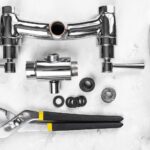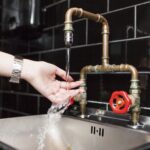Is your bathtub taking longer to drain than usual? A slow-draining bathtub isn’t just an annoyance; it can also be an indication of underlying plumbing issues that you’d wish to nip in the bud without immediately resorting to a plumber. In this guide, we’ll walk you through practical techniques to clear those stubborn clogs, arming you with the knowledge and confidence to tackle this common household woe yourself.
- Learn how to inspect common problem areas that might be causing your bathtub to drain slowly.
- Discover the surprising effectiveness of household items like baking soda and vinegar in loosening stubborn clogs.
- Explore more advanced techniques using basic plumbing tools to clear persistent blockages effectively.
By following these straightforward strategies, you’ll not only reclaim your tub’s optimal draining speed but also gain valuable DIY plumbing skills. Dive into this article to transform what seems like a daunting task into a manageable and rewarding home challenge.
Advanced Techniques in How to Fix a Slow-Draining Bathtub: Clear Stubborn Clogs Without Calling a Plumber
If you’ve tried household remedies and your bathtub is still draining slowly, it’s time to delve into more advanced techniques. Don’t worry; these methods are straightforward and require only basic plumbing tools, which are typically available at most home improvement stores.
Using a Plunger Effectively
A plunger is one of the simplest tools for clearing blockages, but it’s essential to use it correctly to maximize its effectiveness. Start by covering the overflow drain with a wet cloth or duct tape to create suction. Place the plunger over the drain and ensure that it’s submerged in water. This is crucial as water, not air, creates the pressure needed to dislodge the clog. Push and pull the plunger with forceful, even strokes for about 20 seconds. Check if the water drains properly afterward.
Employing a Drain Snake
If a plunger doesn’t solve the problem, a drain snake, also known as a plumber’s snake, can tackle deeper obstacles in your pipes. Insert the flexible end of the snake into the drain, rotating it clockwise as you push it forward. When you feel resistance, you’ve likely hit the clog. Continue twisting to break up the blockage and then slowly retract the snake. Run hot water to flush out the remaining debris.
Both plungers and snakes can effectively resolve stubborn clogs, giving you a draining bathtub without the need for professional intervention. Keep these tools on hand to swiftly address future issues, maintaining your plumbing system’s efficiency.
Initial Steps in How to Fix a Slow-Draining Bathtub: Clear Stubborn Clogs Without Calling a Plumber
Before delving into the more technical aspects of unclogging your bathtub, it’s essential to begin with a careful inspection of the most likely problem areas. This preliminary step can often save time and prevent unnecessary work.
First, remove any visible hair or debris around the drain, as these are common culprits in slow-draining bathtubs. Check the plug mechanism to ensure it is not obstructed by accumulated grime or residue.
Next, fill the bathtub with a small amount of water and observe how well it drains. This initial test will help you gauge the severity of the clog. If the water drains slowly but eventually empties, you may be able to address the issue with simple household remedies.
Inspect the overflow plate and ensure it’s not contributing to the problem. Sometimes, adjusting or clearing out this component can alleviate slow drainage without further intervention.
Move on to the plumbing pipes. Look for any visible signs of obstruction along the pipes leading away from the drain. Often, these early checks can reveal easily accessible blockages.
Using Household Items to Tackle Clogs
Once you’ve identified potential problem areas, using household items can be an effective and eco-friendly way to address pesky blockages. A popular method is the baking soda and vinegar solution.
Start by pouring a pot of boiling water down the drain to loosen any initial clogs. Follow this by adding half a cup of baking soda directly into the drain.
Next, combine a cup of vinegar with a cup of hot water and pour this mixture down the drain over the baking soda. The chemical reaction can break down minor clogs and clean the pipes.
Let the mixture sit for about 15 minutes and then flush the drain with another pot of boiling water to clear away the loosened debris.
This environmentally-friendly solution not only helps tackle slow-draining bathtubs but also minimizes reliance on harsh chemical drain cleaners. Try this method first before resorting to more intensive plumbing tools.
FAQs on Fixing a Slow-Draining Bathtub
What causes a slow-draining bathtub?
Common culprits include:
- Hair buildup.
- Soap scum accumulation.
- Mineral deposits.
Can household items effectively clear clogs?
Yes, using items like baking soda and vinegar can be effective. These create a fizzing reaction to break down clogs.
How often should I clean my drain to prevent clogs?
Regular maintenance is key. It’s advisable to clean your drain at least once a month.
What’s the best tool for stubborn clogs?
A plumbing snake is effective for clearing stubborn clogs. It can reach deep into the drain to break up blockages.
Is it safe to use chemical drain cleaners?
Use with caution. While effective, they can damage pipes over time and pose health risks.





